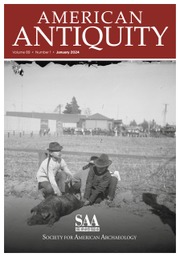No CrossRef data available.
Article contents
A Multi-evidential Approach to Locating Chichilticale of the 1539–1542 Coronado Expedition
Published online by Cambridge University Press: 04 April 2025
Abstract
Chichilticale is a long-sought-after location on the Coronado expedition route in southeastern Arizona. It is referred to numerous times in documents, and various expedition members stayed there, making it potentially one of the most discoverable of the Coronado expedition camp sites. Nonetheless, it remained lost until recently when data from a variety of sources provided a basis to establish hypotheses that were then tested and retested until Chichilticale was located. This site, 1 km long, has hundreds of Spanish period artifacts related to the 1539–1540 two-month winter encampment established during Melchior Díaz's reconnaissance north to check on Fray Marcos de Niza's report. Crossbow bolt heads, copper lace aglets, caret- or gable-headed nails, copper bells, and many other artifacts and features provide a surprisingly rich archaeological record of this place and of an unexpected and unrecorded battle that changes history for the Sobaipuri O'odham.
Resumen
Chichilticale es un lugar muy buscado en la ruta de la expedición de Coronado en el sureste de Arizona. Como lugar con nombre, se hizo referencia a él numerosas veces en los documentos y varios miembros de la expedición se quedaron allí, lo que lo convierte potencialmente en uno de los campamentos de la expedición de Coronado más fáciles de descubrir. Sin embargo, permaneció perdido hasta hace poco, cuando datos de una variedad de fuentes proporcionaron una base para establecer hipótesis que luego fueron probadas una y otra vez hasta que se localizó Chichilticale. Este sitio de 1 km de largo tiene cientos de artefactos del período español relacionados con el campamento de invierno de dos meses de 1539–1540 establecido durante el reconocimiento al norte de Melchior Díaz para verificar el informe de Fray Marcos de Niza. Cabezas de virotes de ballesta, herretes de encaje de cobre, clavos con cabeza de caret o hastial, campanas de cobre y muchos otros artefactos y elementos proporcionan un registro arqueológico sorprendentemente rico de este lugar y de una batalla inesperada y no registrada.
Keywords
- Type
- Article
- Information
- Copyright
- Copyright © The Author(s), 2025. Published by Cambridge University Press on behalf of Society for American Archaeology


